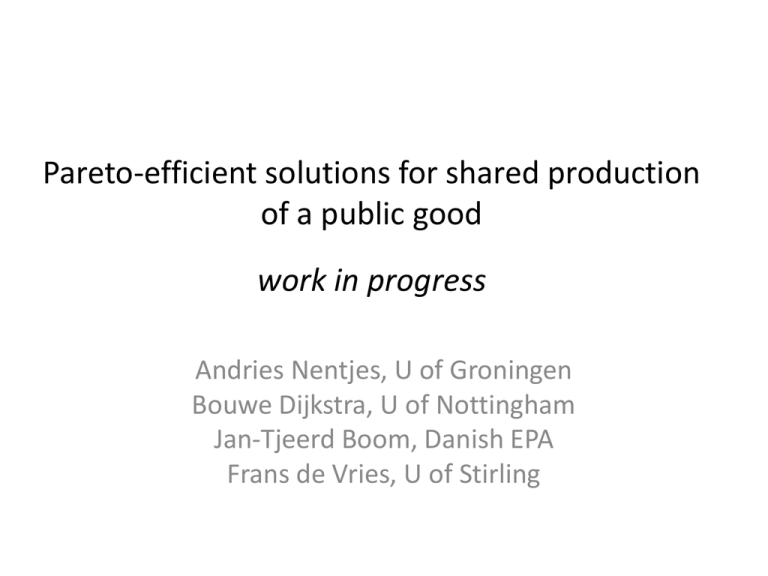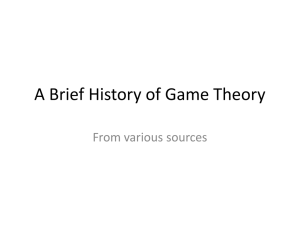Pareto-efficient solutions for shared production of a public good
advertisement

Pareto-efficient solutions for shared production of a public good work in progress Andries Nentjes, U of Groningen Bouwe Dijkstra, U of Nottingham Jan-Tjeerd Boom, Danish EPA Frans de Vries, U of Stirling 1. Introduction • Private provision of a public good • International examples: – Greenhouse gas emission reduction – Military alliances • Nash equilibrium: Underprovision 2 A “new” solution: Market Exchange • Nentjes (1990) • How much yi of the public good would you be willing to supply if you would get Yi = piyi from the group in return? • Equilibrium prices where all Yi = Σyj – Unique stable equilibrium 3 Comparison • This paper: Nash bargaining • Nentjes, Rübbelke, Dijkstra, De Vries: – Kaneko ratio equilibrium – Guttman matching scheme – Andreoni-Bergman tax-subsidy scheme – Falkinger tax-subsidy scheme – Roemer’s Kantian equilibrium 4 Nash bargaining • Constructed to have desirable outcomes • Bargaining process itself is black box • Noncooperative implementation – Binmore et al. ’86: 2 players, alternate offers – Chae&Yang ’94, Krishna&Serrano ’96, Hart&Mas-Colell ’96: n players, specific bargaining procedure, equilibrium concept – Requires full information 5 Outsourcing • E.g. emission trading • Each agent commits to a certain public good contribution • Agent i who produces more than her contribution earns certificates which she can sell to another agent j – Agent j can produce below contribution 6 Literature: International environmental policy • Hoel (1991): Nash bargaining without emission trading • Helm (2003): Noncooperative emission reduction with and without emission trading • Boom (2006 thesis): Nash bargaining with and without emission trading 7 Outline 2. The model 3. Nash bargaining without outsourcing 4. Market exchange without outsourcing 5. Outsourcing 6. Conclusion 8 2. The model • n agents (i = 1,...,n) producing and consuming a public good Q = Σqi • Cost function Ci(qi) with Ci’, Ci’’ ≥ 0 • Benefit function Bi(Q) with Bi’ ≥ 0, Bi’’ ≤ 0 • Specific case: two agents, quadratic functions 1 2 Ci (qi ) ci qi 2 1 2 Bi (Q) bi Q bi Q 2 Ci ' (qi ) ci qi Bi ' (Q) bi (1 Q) 9 Constrained Pareto efficiency • Without side payments max B1 (Q) C1 (q1 ) k Wk Bk (Q) Ck (qk ) n qi k 2 • nFOCs j B j ' (Q) i Ci ' (qi ) 0 or j 1 n B j ' (Q) C ' (q ) 1 j 1 j j C1 ' (q1 ) • Welfare weights λ1 = 1 and k Ck ' ( qk ) • λk and qi not determined 10 Unconstrained Pareto efficiency • With side payments, agent i receives xi n max B1 (Q) C1 (q1 ) x1 j W j B j (Q) C j (q j ) x j x1 x j qi , xi j 2 j 2 n • FOC for xi: λj = μ = 1 • FOC for qi: n B ' (Q) C ' (q ) 0 j 1 j i i • All λj and qi determined, but xi not determined 11 Noncooperative Nash (NCN) max Bi (Q) Ci (qi ) qi • FOCs Bi ' (Q) Ci ' (qi ) 0 • Not Pareto-efficient (underprovision) 12 3. Nash bargaining • With equal bargaining weights (A NCN payoff) j n max log B j (Q) C j (q j ) A j qi • FOCs n j 1 B j ' (Q) Ci ' (qi ) Bi (Q) Ci (qi ) Ai j 1 B j (Q) C j (q j ) A j • Constrained Pareto optimal, generally unequal welfare weights 1 i Bi (Q) Ci (qi ) Ai • Higher gain: Lower welfare weight, higher Ci’ 13 4. Market Exchange Solution • How much yi of the public good would you be willing to supply if you would get Yi = piyi from the group in return? – On top of the NCN amounts qin, Qn max Wi Bi (Qn Yi ) Ci (qin yi ) s.t. Yi pi yi 0 yi • FOCs pi Bi ' (Qi ) Ci ' (qi ) • Agent i supplies yi, demands Yi 14 Equilibrium • All agents demand the same amount, which is the sum of all their supplies: n Yi Y y j • Equilibrium prices Yi Y pi yi yi yi 1 • Agent i’s supply share Y pi j 1 • Constrained Pareto optimal: n Bi ' (Q) n 1 n yi 1 i 1 Ci ' (qi ) i 1 pi i 1 Y 15 Two agents, quadratic benefits and costs Ci (qi ) ci qi Bi ' (Q) bi (1 Q) bi gi ci • MES and NBS coincide – Probably not a general result • Agent with highest gi has highest qi • c1 = c2: High-benefit agent has highest Ci’ • b1 = b2: High-cost agent has highest Ci’ 16 5. Outsourcing • Stage 1: Each agent commits to a certain public good contribution • Stage 2: Agent i who produces more than her contribution earns certificates which she can sell to another agent j – Agent j can produce below contribution 17 Stage two max Wi Bi (Q) Ci (qsi ) P(qsi qi ) qsi • qsi = production, qi contribution • P(Q) certificate price (perfect competition) • FOC P Ci ' (qsi ) 0 18 Nash bargaining n max J logBi (Q) Ci (qsi ) P(Q)(qsi qi ) Ai qi i 1 • FOC n B j ' (Q) P' (Q)(qsj q j ) j 1 W j Aj P(Q) 0 Wi Ai • All Wi – Ai must be the same 19 Unconstrained Pareto optimum n n B ' (Q) P' (Q) (q j 1 j j 1 sj q j ) P(Q) • Market clearing and perfect competition on certificate market: n B ' (Q) P(Q) C ' (q j 1 j i si ) • Outsourcing as a vehicle for side payments 20 Market exchange solution maxWi Bi (Qn Yi ) Ci (qin ysi ) P( ysi yi ) yi s.t. Yi pi yi 0 • FOC pi Bi ' (Q) pi P' (Q)( ysi yi ) P 0 yi • In equilibrium: Bi ' (Q) P' (Q)( ysi yi ) P Y • Sum over i: n B ' (Q) P C ' (q ) i 1 i j • Unconstrained Pareto optimum j 21 Contributions n • Substituting P Bi ' (Q) back into i 1 yi Bi ' (Q) P' (Q)( ysi yi ) P Y yields yi Bi ' (Q) P' (Q)( ysi yi ) Y B j ' (Q) • Every agent contributes in proportion to her marginal benefits, adjusted by price manipulation motive • Remember with NBS: Every agent has the same gain 22 Lindahl pricing? • Ask every public good consumer i how much he would demand at price pi • Public good is supplied efficiently – Only with outsourcing • MES contributions with outsourcing: yi Bi ' (Q) P' (Q)( ysi yi ) Y B j ' (Q) – Lindahl – Producer’s price manipulation motive 23 Two agents, quadratic benefits and costs Ci (qi ) ci qi Bi ' (Q) bi (1 Q) • Comparing MES and NBS • Identical benefit functions: – High-cost agent pays low-cost agent • Identical cost functions: – High-benefit agent pays low-benefit agent • Payments lower in MES than in NBS – Attempts to manipulate the permit price 24 6. Conclusion • Comparison of Nash bargaining and market exchange solutions for public good provision – Example: Two agents, quadratic benefits and costs • Without outsourcing: both are constrained Pareto-optimal – MES and NBS coincide • With outsourcing: both are unconstrained Pareto-optimal – Smaller transfers in MES 25 Extensions • Other functional forms • Asymmetric information • Coalition formation • Climate change policy simulations • Experiments 26








